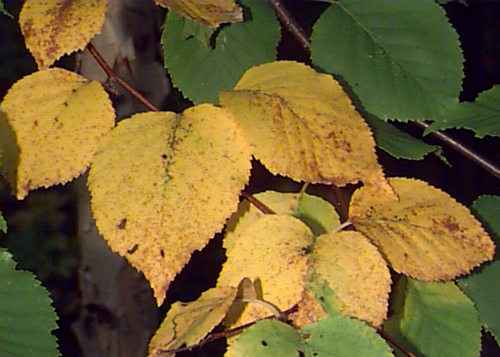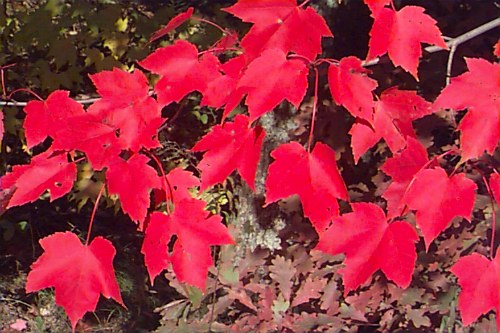Fall in New England. Even those of us who have lived here for years or grown up here look forward to the annual brilliant display of color. The duration and intensity of color and even the proportion of reds vs. yellows changes from one year to the next. What are the factors that initiate and control these changes in the leaves? Decreasing day length, temperature and moisture all play a role.
During the summer, there is a lot of chlorophyll, or green pigment in the leaves. Chlorophyll is where energy from the sun is used by the plant to manufacture sugars using water and carbon dioxide in the process of photosynthesis. Orange and yellow pigments, carotenes and xanthophylls respectively, are always present in the leaves but they are masked during the summer by the abundant chlorophyll. Chlorophyll is rapidly broken down by sunlight. During the summer, when temperatures are warm, plenty of new chlorophyll is produced to replace that which is lost. When temperatures begin to cool, and plant hormone levels change in response to decreasing day length, chlorophyll synthesis drops off and the other pigments become visible. Carotenes and xanthophylls are more stable than chlorophyll and remain intact as the chlorophyll is lost.
Paper birch leaves turn a bright yellow in the fall. (www.hort.uconn.edu).
Red pigments, or anthocyanins, are not present during the summer. They are formed from sugars that build up in the leaf tissue and the amount of red pigment formed is dependent on the weather, tree species, and the acidity of the leaf. Sugar is usually transported out of the leaves to other parts of the plant such as the roots or developing seeds and fruits. Another phenomenon that occurs along with the change in leaf color is the formation of the abscission layer, the point at the base of the petiole or leaf stalk where the leaf breaks from the twig when it falls. As this layer forms, movement of sugar out of the leaf becomes restricted, resulting in the accumulation of sugars in the leaf while there is still some photosynthesis going on in the remaining chlorophyll.
Red maple leaves can be striking. (www.hort.uconn.edu)
Weather favorable to the formation of red pigments is sunny, cool (but not freezing) and dry. Early frost (which we haven’t had this year!) weakens red pigment production. Overall, the best and most showy fall color seasons result when we have dry, sunny weather during the day and cool nights. Trees that are usually yellow in fall include birch, white ash, poplar, beech, and hickory. Those that produce the best reds include red and sugar maple, red oak, dogwood, and mountain ash (not a true ash).
What about brown leaves? Some trees, including many oak species, really just turn brown, and some hold onto their leaves until new ones begin to push out in the spring. Brown color is from a build-up of tannins, a waste product of physiological processes in the leaves.
If you’re interested in a fun do-it-yourself look at the various pigments in a leaf using chromatography, follow these instructions from the website of the Buffalo Museum of Science:
You will need: Isopropyl alcohol, hot water, a coffee mug, a soup dish, a pencil, scissors, plastic wrap, and some filter paper (a coffee filter is perfect).
1. Take 2-3 green tree leaves and cut them into small pieces with the scissors. Crush or crumble them into the coffee mug
2. Use very hot tap water to fill the soup dish half full. Place the coffee mug containing the leaves into the hot water in the dish.
3. Add isopropyl alcohol to the coffee mug to just cover the leaf pieces. Soak the leaves in the alcohol for an hour or more. Put plastic wrap over the mug to reduce evaporation. When the hot water cools, replace it with fresh hot water to keep the alcohol warm. Watch for the alcohol to turn a dark color as pigments dissolve into it.
4. Using scissors, cut the filter paper into 1 or 2 strips about 4 inches long by 1-2 inches wide. Using the pencil resting atop the coffee mug, drape the filter paper strips over the pencil so that one end is touching the bottom of the mug through the liquid. Secure the filter paper to the pencil with a small piece of tape if needed. Replace the plastic wrap over the top of the mug, pencil and filter paper strips.
5. The alcohol will move up the filter paper bringing pigments from the leaf with it. The pigments will move up the paper at different rates and after 30-45 minutes you will see them separate.
6. Try this experiment with ink too! Make a mark with a black ball point pen on the filter paper, just above the level of the alcohol and see what colors combine to form black ink.
Take time to enjoy the fall colors while they last!
Submitted by J. Allen for UConn Extension

